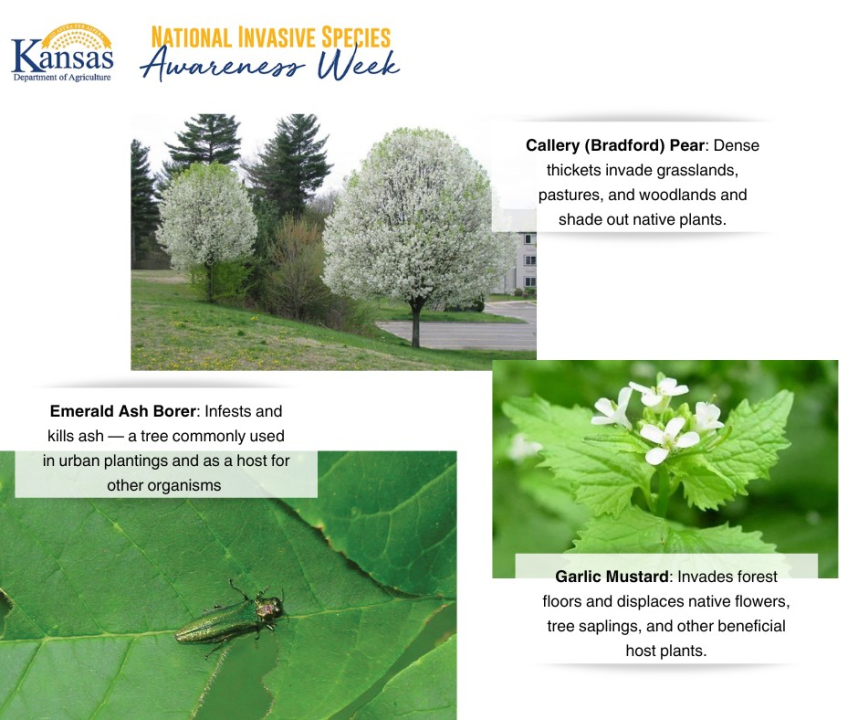‘Spreading rapidly’: KDA highlights invasive species

TOPEKA (KSNT) – As part of National Invasive Species Awareness Week (NISAW), the Kansas Department of Agriculture (KDA) highlighted some of the worst invasive species of plants and animals in the state.
The KDA highlighted six particularly invasive species on Monday, these included: the Spotted Lanternfly, Spongy Moth, Red Imported Fire Ant, Callery (Bradford) Pear Tree, Emerald Ash Borer and Garlic Mustard (alliaria petiolata).
The Kansas Forest Service (KFS) is joining the KDA in NISAW by sharing species that are “spreading rapidly into our woodland, prairies, and other native ecosystems.”
Images courtesy of the Kansas Department of Agriculture. Images courtesy of the Kansas Department of Agriculture.
Shawnee Co. teen arrested for potential school threats
Spotted Lanternfly:
Native to China, the Spotted Lanternfly was first found in Pennsylvania and has since been reported in Connecticut, Delaware, Indiana, Maryland, Massachusetts, Michigan, New Jersey, New York, North Carolina, Ohio, Rhode Island, Virginia and West Virginia.
The spotted lanternfly usually lays its eggs on smooth surfaces and can be found in crevices on trees, rocks or fences, according to the Indiana Department of Natural Resources.
The spotted lanternfly feasts off of fruit, ornamental and woody trees, especially the tree of heaven, a fellow invasive species native to China, according to the USDA. Specifically, the spotted lanternfly feeds on sap from over 70 different plant species, PennState Extension explains. The damage left behind can cause the plant to stress, draining its health and potentially killing it.
To read more on the Spotted Lanternfly, click here.
Spongy Moth:
The spongy moth is an invasive pest that feeds on more than 300 trees and shrubs. The moth spawns in large cycles every eight to 12 years. The population cycles can cause a nuisance and cause widespread defoliation, according to the Minnesota Department of Natural Resources (MDNR).
Spongy moth eggs are well camouflaged and can blend in with firewood and other outdoor equipment, according to the MDNR.
For more information about the Spongy Moth, click here.
Project closes major downtown Manhattan street
Callery (Bradford) Pear Tree:
Recent efforts on the part of the KFS, Deep Roots KC and Evergy have attempted to replace Callery pear trees with native varieties of trees. Callery pear trees are considered a problem due to their tendency to break apart during storms and overwhelm native plants by creating dense thickets.
KDA spokeswoman Heather Lansdowne said the tree’s inherent invasiveness and its ability to spread to areas outside where it’s planted have prompted the KDA to look for solutions on how to restrict their spread in Kansas.
For more information on the Callery Pear Tree, click here.
Emerald Ash Borer:
Emerald ash borers were first discovered in Kansas in 2012, according to K-State. They have spread to 30 states and are responsible for the destruction of millions of ash trees across 16 different species.
The emerald ash borer is a green, wood-boring beetle that kills ash trees by eating tissues under the bark, according to K-State. Adults emerge in mid to late-May from infestations in trees from the previous year and lay eggs a short time later.
The larvae then bore into the tree and feed under the bark, leaving tracks underneath. Small trees can die within one to two years after initial infection while larger trees may live on for three to four years.
For more information on the emerald ash borer, click here.
Garlic Mustard (alliaria petiolata):
Garlic mustard, also known as hedge garlic, sauce-alone, garlic root and poor man’s mustard is a highly destructive plant that poses a particular threat to the rare West Virginia white butterfly.
Native to Europe and Asia, garlic mustard was first reported in North America in 1868 on Long Island, New York. Garlic mustard is considered an invasive species for evergreen woodlands. The species is known to dominate herb layers and can inhibit oak regeneration.
Garlic mustard is now considered a ‘category 1’ invasive species by the Vermont Department of Environmental Conservation.
For more information on garlic mustard, click here.
World-famous Lego builder coming to Topeka Zoo
Red Imported Fire Ant:
The red imported fire ant (RIFA) is believed to have been brought to the USA from South America in ship’s ballasts between 1933 and 1945. Since its introduction to the USA, the species has spread to infest more than 3.5 million square miles.
The ant can cause painful stings on humans, pets and livestock, according to the National Invasive Species Information Center. The ant will prey on ground-nesting birds, lizards and other wildlife, according to a report by the Louisiana State University School of Veterinary Medicine.
For more information on RIFA, click here.
For more Kansas news, click here. Keep up with the latest breaking news in northeast Kansas by downloading our mobile app and by signing up for our news email alerts. Sign up for our Storm Track Weather app by clicking here.
For the latest news, weather, sports, and streaming video, head to KSNT 27 News.



